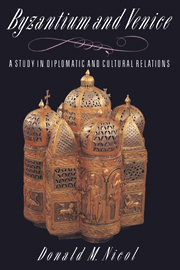Book contents
- Frontmatter
- Contents
- Dedication
- Preface
- List of abbreviations
- Maps of the Byzantine and Venetian worlds
- 1 Venice: the Byzantine province
- 2 Venice: the Byzantine protectorate
- 3 Venice: the ally of Byzantium
- 4 Venice: the partner of Byzantium
- 5 Byzantium, Venice and the First Crusade
- 6 The parting of the ways
- 7 The calm before the storm
- 8 The Fourth Crusade
- 9 Venice in Byzantium: the Empire of Romania
- 10 Venice: champion of a lost cause
- 11 Byzantium, Venice and the Angevin threat
- 12 Byzantium, Venice and Genoa
- 13 Conflicting interests and competing claims
- 14 Byzantium, Venice and the Turks
- 15 Byzantium: the victim of commercial rivalry
- 16 The profit and honour of Venice
- 17 Jewels for an island
- 18 Byzantium in thrall to the Turks and in debt to Venice
- 19 Byzantine optimism and Venetian vacillation
- 20 Byzantium the suppliant of Venice
- 21 The worst news for all of Christendom: Venice and the fall of Constantinople
- 22 Legacies and debts
- Byzantine Emperors
- Doges of Venice
- Bibliography
- Index
4 - Venice: the partner of Byzantium
Published online by Cambridge University Press: 01 April 2010
- Frontmatter
- Contents
- Dedication
- Preface
- List of abbreviations
- Maps of the Byzantine and Venetian worlds
- 1 Venice: the Byzantine province
- 2 Venice: the Byzantine protectorate
- 3 Venice: the ally of Byzantium
- 4 Venice: the partner of Byzantium
- 5 Byzantium, Venice and the First Crusade
- 6 The parting of the ways
- 7 The calm before the storm
- 8 The Fourth Crusade
- 9 Venice in Byzantium: the Empire of Romania
- 10 Venice: champion of a lost cause
- 11 Byzantium, Venice and the Angevin threat
- 12 Byzantium, Venice and Genoa
- 13 Conflicting interests and competing claims
- 14 Byzantium, Venice and the Turks
- 15 Byzantium: the victim of commercial rivalry
- 16 The profit and honour of Venice
- 17 Jewels for an island
- 18 Byzantium in thrall to the Turks and in debt to Venice
- 19 Byzantine optimism and Venetian vacillation
- 20 Byzantium the suppliant of Venice
- 21 The worst news for all of Christendom: Venice and the fall of Constantinople
- 22 Legacies and debts
- Byzantine Emperors
- Doges of Venice
- Bibliography
- Index
Summary
The native sources for the history of Venice in the middle years of the eleventh century are not plentiful. The Chronicle of John the Deacon ends in the year 1008. The Chronicle of Andrea Dandolo was not composed until the fourteenth century and derives many of its unverifiable and often distorted facts from lost sources and documents. The history of Byzantium in the eleventh century is by contrast well documented by a number of well-informed and sophisticated historians such as Michael Psellos, Michael Attaleiates, John Skylitzes and John Zonaras, even though Venice was not often in the forefront of their minds. So far as is known, the new Doge Domenico Flabianico, elected in 1032, had few formal dealings with Constantinople, though he bore the Byzantine title of protospatharios; and his successor, Domenico Contarini (1043–70), was entitled imperial patrician and anthypatos, as well as magistros. He was the first of the Doges to be so honoured, and the title may be evidence of the value which the Byzantine Emperors set upon their continuing relationship with Venice. The arrest and exile of the last of the Orseoli may have caused a certain coolness between the two. It could not be allowed to last if Venice was to survive and prosper as an independent state.
In the wider context of European history the eleventh century was the age in which the balance of power began to shift decisively from east to west. At its beginning the Byzantine Empire under Basil II was greater in extent and richer in resources than any of its rivals or competitors.
- Type
- Chapter
- Information
- Byzantium and VeniceA Study in Diplomatic and Cultural Relations, pp. 50 - 67Publisher: Cambridge University PressPrint publication year: 1989



